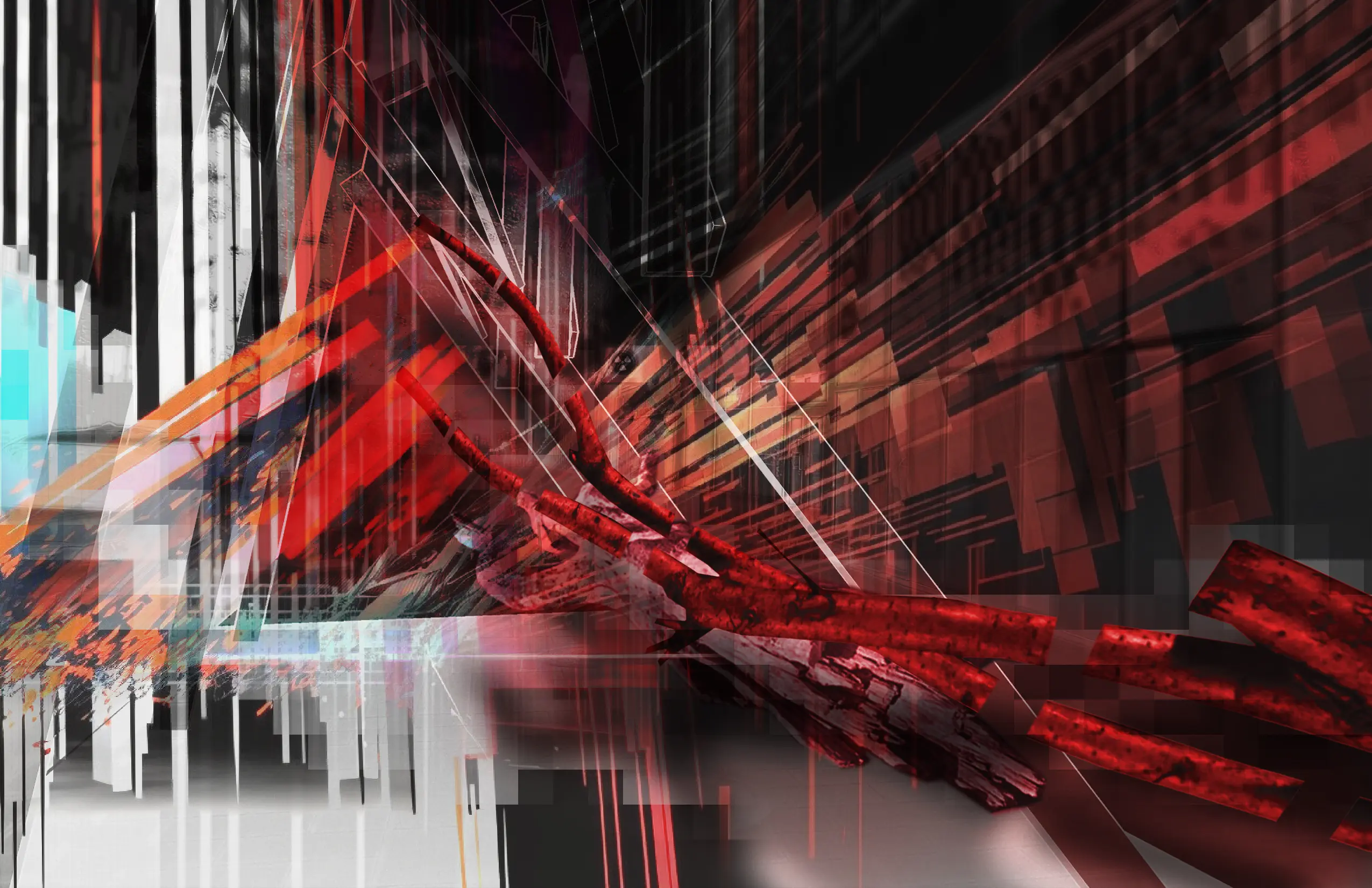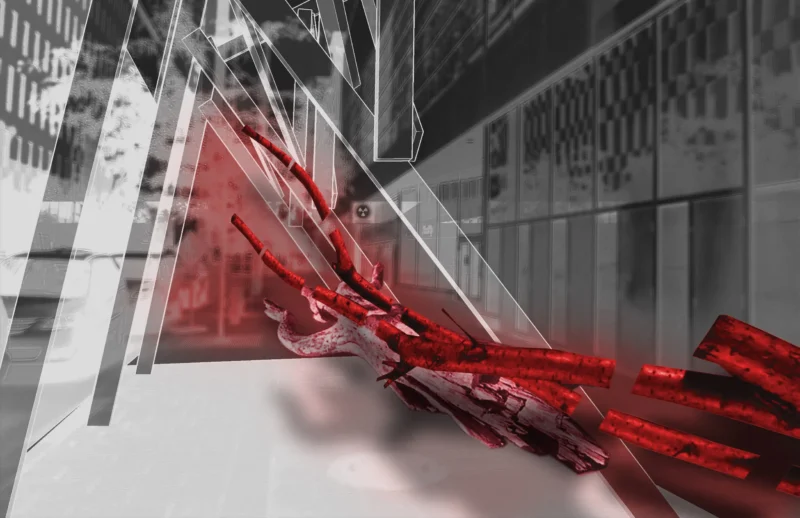FALLING FOREST | CHERNOBYL | 2008
How I stole the
Tree of Half-Life
from Chernobyl
“Radioactive traces will be the heritage to the next generations and not the cultural artifacts.”
Margit Rosen on Pulse8 by Michael Saup, 1992
Falling Forest – 2008 | How I Stole The Tree of Half-Life
“After I had left the zone, I realized, that the zone was everywhere!”
Falling Forest redefines a sidewalk in Montreal’s Quartier International commercial district. The installation explores the implications of nuclear power and its relationship to natural ecosystems. Our understanding of this relationship is in constant evolution. Falling Forest provides the setting for a deconstructed tree that is partially exhumed from the so-called “Red Forest” adjacent to the nuclear disaster at Chernobyl.
This tree is suspended within the space and lit with red LED light. A Geiger counter mounted within the installation’s floor measures radiation. These readings are played back through an audio speaker. The primary building material is wood, a product of the forest. An abstraction of a tree-lined boulevard is created using wooden studs, OSB panels and LED lighting. Power for the LED lighting is drawn from the existing street lights.

PREFACE
Paradise was an exclusion zone guarded by the archangels of the Russian military, an alienated void inhabited by animals, angels and power plants. Inside the rotten apple rested the core. The core that fell on Earth as a star. The Fall out of Paradise had sealed the zone forever. Still remaining in the garden: the forgotten tree of life: the tree of half-life.
CREATION OF THE NUCLEAR ORACLE
PROCESS DIARY
- Quantengeist travels to the exclusion zone of the Chernobyl reactor in the Ukraine former Russia.
- Quantengeist meets the remains of the radioactive Red Forest.
- Quantengeist cuts a radioactive tree and brings it to Canada.
- Quantengeist meets the remains of the Canadian Forest.
- Quantengeist cuts a tree in Canada to amplify the Ukrainian wood.
- Quantengeist exhibits the combined tree in Montreal.
- Quantengeist creates the forgotten oracle of the red forest: the nuclear treenity.
- Quantengeist describes the smallest indivisible articulation of reality being the fabric of the absolute body.
- Quantengeist adores the articulation of the supreme.
INFOSSIL ARCHAEOLOGY OF THE NUCLEAR PLEXUS
Growing up in the Killertal, living very close to the botanical monoculture of the Black Forest in Germany, I had been irritated and fascinated by the myth of the Red Forest near the Chernobyl Nuclear Power Plant. I heard that in 1986, after the reactor blew up, the forest around the reactor would be glowing red at night for 3 months.
This story being true or not, as a matter of fact, the trees turned red after they died following the absorption of high levels of radiation from the disaster. The Red Forest was cut and buried, the first time, that infossilation of carbon culture was induced. Today, 22 years later, all of us are saving the planet. The nuclear nightmare has completely disappeared. Really? As a matter of fact I sense something different: the real manifestation of the nuclear age, the birth of the nuclear plexus introducing hindu-blue Big-Bang-Recycling, Star-Ignition-Factories and infossil supersymmetry creating local irregularities in the cosmic grid.
Finding a tree of the Red Forest and bringing it to Montreal to be exhibited in public territory gives us the opportunity to ask shy questions to this forgotten interface between future and past: the nuclear oracle of the Red Forest.

DESCRIPTION OF THE INSTALLATION
Light is very new, from the future, magic LED indirectly radiating. Transcending space. A nuclear Zen Garden. Positive Shadow. The tree of life. The tree of half-life. Between carbon and contamination. Between fossil and infossil. Interface between future and past. Carrier of light. Only 2 things will survive and leave our system: radiowaves and depleted uranium-238. Remaining for another 4.5 billion years as human creation, as cultural artifact.
With the promise of radiant soil, I entered No-mans-land, to crop the forbidden tree of half-life in the cosmic rain of radiance. The nuclear seed of fertility and fate. Atom of divine knowledge. Forbidden bit. Radiant fruit.
O Omnipresent, root of the Treenity, we salute you!
CREDITS
- Michael Saup, Artist
- Howard Davies, Anne Cormier, Randy Cohen, Atelier Big City, Architects, Canada
- Cecile Martin, Champ Libre, Artistic Director, Canada
- Yves Deschênes, Champ Libre, Technical Director, Canada
- Duncan Swain, Construction, Canada
- Wolfgang Eppler & Bernd Reinhardt, Karlsruhe Institute of Technology, Support, Germany
- Adeline Dekeukelaire & Emilie Graves, Champ Libre, Assistance, Canada
- Pierre Giroux, Fonderie Darling, Technical Director & Deforestation, Canada
- Gallery Samuel Lallouz, Montreal, Canada
- Cet Merlin & Unit Labs, Soundtrack, Germany
- ehrenwert.com, Equipment, Germany
- Zana Bosnjak, Support Kiev & Berlin, Ukraine
- Li Alin, Apartment 111, Canada
- Tarik and Dimitri, Transport Kiev, Ukraine
- Julia Herzog, Coordination Berlin
- Russian wildfire video by vykza 2010
- Fukushima footage, japanese TV station 2011
“the road burns…no…no…tell you, the road really burns!…softly-softly-softly…shoot.. (shit)…motherfuckers!…goddamn, how to get through?…softly-softly-softly…come on, come on, now we can get out…no, we can’t…stop…stop…fuck, I tell you stop!…go back, you motherfucker!…come on, go back, asshole you…go ahead…are you filming?…yes, i do…shoot (shit)…ah…”

https://champ-libre.org/foret/uk/pavillons.html
FROM CHERNOBYL TO MONTREAL, THE INCANDESCENT ZEN GARDEN
FALLING FOREST = ROOT LOG, by artist Michael Saup aka Quantengeist (Germany) + CHABLIS, by architects Howard Davies, Randy Cohen and Anne Cormier of the Atelier Big City (Montreal)
FALLING FOREST incarnates a collision in the form of a monumental skewed elevation, occupying a simple sidewalk. This structure stages the fortuitous meeting of city and forest, embodying the moment at which contemporary society suddenly feels the need to preserve the forest and allow it to follow its fragile destiny, so that we do not contribute to its destruction. CHABLIS, a forest of wooden farms, aligns itself with ROOT LOG in an audio-visual amplification of the eternal traces left by humanity on nature. The natural phenomena of radioactivity and sound waves are amplified, with the Falling Forest illuminated night and day by a red light, the same one that made the forest – the Red Forest – adjacent to the Chernobyl nuclear reactor vibrate.
Michael Saup is an electronic artist, a movie director, and musician. Since the 1990’s, he has been one of Europe’s major protagonists of computer-generated art. His work, often in collaboration with other established figures of the arts, including Steina Vasulka, Richard Castelli, Peter Weibel, and William Forsythe, has been presented in many international contexts. He is one of the founding professors of the Hochschule fuer Gestaltung (Hfg), Germany’s largest school for arts and new technology, attached to the Zentrum fuer Medientechnologie Karlsruhe (ZKM), where he taught for many years. He works and lives in Berlin.
Atelier Big City (Cormier, Cohen, Davies architects) has a marked interest in the city in all its manifestations. The motto “make architecture a public policy” underlines the importance that the atelier grants to the public role of architecture. Many prizes, publications and invitations to present and exhibit its projects in America and Europe bear witness to its contribution to the dynamism of Quebec architecture. Atelier Big City was awarded the Canada Council for the Arts’ Prix de Rome in 1998.
A « SUPRA CURATOR »
Cécile Martin, Champ Libre’s general and artistic director, has played a major role in the creation of the artworks presented within FOREST. During the Spring of 2008 and following an international call, to which more than 100 projects were submitted, the programming committee composed of Mirko Zardini, director of the Canadian Centre for Architecture (CCA), Sophie Gironnay, director of the MONOPOLI architecture gallery, Andrée Duchaine, director of Groupe Molior, and Jean Gervais, director of Hexagram UQAM, named Cécile Martin supra curator of the event, bestowing her the mandate to select the artists and architects for the event. Martin, herself a trained architect (MArch) and artist, invited and orchestrated encounters between creators whose work or approach had already explored the theme of the forest. The goal of these meetings was to reveal and link different contemporary stances, views, approaches, and spaces of exploration constituting the four axes of the organization’s mandate: art, architecture, new technologies, and public space.